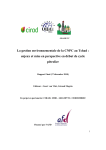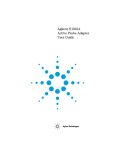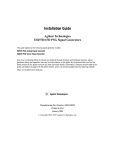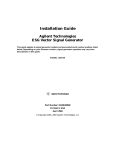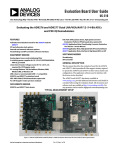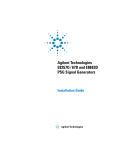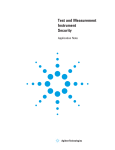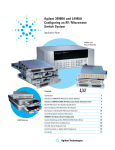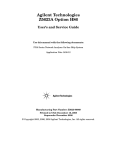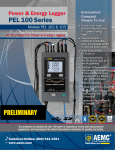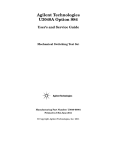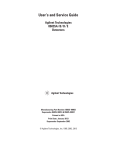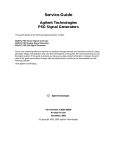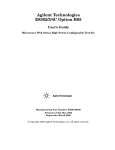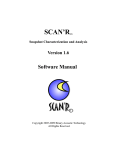Download Agilent Technologies E8257C PSG Technical data
Transcript
Agilent Technologies E8247C and E8257C/D Option H30 User’s and Service Guide Supplement Agilent Technologies E8247C and E8257C/D Option H30 User’s and Service Guide Supplement Use this manual with the following documents: PSG Family User’s Guides: E8251-90253 E8251-90259 E8251-90353 E8251-90359 Manufacturing Part Number: E8251-90072 Printed in USA November 2005 © Copyright 2003, 2005 Agilent Technologies, Inc. All rights reserved. Warranty Statement THE MATERIAL CONTAINED IN THIS DOCUMENT IS PROVIDED “AS IS,” AND IS SUBJECT TO BEING CHANGED, WITHOUT NOTICE, IN FUTURE EDITIONS. FURTHER, TO THE MAXIMUM EXTENT PERMITTED BY APPLICABLE LAW, AGILENT DISCLAIMS ALL WARRANTIES, EITHER EXPRESS OR IMPLIED WITH REGARD TO THIS MANUAL AND ANY INFORMATION CONTAINED HEREIN, INCLUDING BUT NOT LIMITED TO THE IMPLIED WARRANTIES OF MERCHANTABILITY AND FITNESS FOR A PARTICULAR PURPOSE. AGILENT SHALL NOT BE LIABLE FOR ERRORS OR FOR INCIDENTAL OR CONSEQUENTIAL DAMAGES IN CONNECTION WITH THE FURNISHING, USE, OR PERFORMANCE OF THIS DOCUMENT OR ANY INFORMATION CONTAINED HEREIN. SHOULD AGILENT AND THE USER HAVE A SEPARATE WRITTEN AGREEMENT WITH WARRANTY TERMS COVERING THE MATERIAL IN THIS DOCUMENT THAT CONFLICT WITH THESE TERMS, THE WARRANTY TERMS IN THE SEPARATE AGREEMENT WILL CONTROL. DFARS/Restricted Rights Notice If software is for use in the performance of a U.S. Government prime contract or subcontract, Software is delivered and licensed as “Commercial computer software” as defined in DFAR 252.227-7014 (June 1995), or as a “commercial item” as defined in FAR 2.101(a) or as “Restricted computer software” as defined in FAR 52.227-19 (June 1987) or any equivalent agency regulation or contract clause. Use, duplication or disclosure of Software is subject to Agilent Technologies’ standard commercial license terms and non-DOD Departments and Agencies of the U.S. Government will receive no greater than Restricted Rights as defined in FAR 52.227-19(c)(1-2) (June 1987). U.S. Government users will receive no greater than Limited Rights as defined in FAR 52.227-14 (June 1987) or DFAR 252.227-7015 (b)(2) (November 1995), as applicable in any technical data. ii Safety Notes The following safety notes are used throughout this document. Familiarize yourself with each of these notes and its meaning before performing any of the procedures in this document. WARNING Warning denotes a hazard. It calls attention to a procedure which, if not correctly performed or adhered to, could result in injury or loss of life. Do not proceed beyond a warning note until the indicated conditions are fully understood and met. CAUTION Caution denotes a hazard. It calls attention to a procedure that, if not correctly performed or adhered to, could result in damage to or destruction of the instrument. Do not proceed beyond a caution sign until the indicated conditions are fully understood and met. Definitions • Specifications describe the performance of parameters covered by the product warranty (temperature –0 to 55 °C, unless otherwise noted.) • Typical describes additional product performance information that is not covered by the product warranty. It is performance beyond specification that 80% of the units exhibit with a 95% confidence level over the temperature range 20 to 30 °C. Typical performance does not include measurement uncertainty. • Nominal values indicate expected performance or describe product performance that is useful in the application of the product, but is not covered by the product warranty. iii iv Contents E8247C and E8257C\D Option H30 Description . . . . . . . . . . . . . . . . . . . . . . . . . . . . . . . . . . . . . . . . . . . . . . . . . . . . . . . . . . . . . . . . . . 2 Nominal Performance Characteristics . . . . . . . . . . . . . . . . . . . . . . . . . . . . . . . . . . . . . . . . . . . . 3 Operation and Performance Verification . . . . . . . . . . . . . . . . . . . . . . . . . . . . . . . . . . . . . . . . . . 5 Documentation Conventions . . . . . . . . . . . . . . . . . . . . . . . . . . . . . . . . . . . . . . . . . . . . . . . . . . 5 Option H30 Operation (520 or 540) . . . . . . . . . . . . . . . . . . . . . . . . . . . . . . . . . . . . . . . . . . . . . 5 Performance Verification . . . . . . . . . . . . . . . . . . . . . . . . . . . . . . . . . . . . . . . . . . . . . . . . . . . . . 6 Troubleshooting . . . . . . . . . . . . . . . . . . . . . . . . . . . . . . . . . . . . . . . . . . . . . . . . . . . . . . . . . . . . . . 7 MID Board or Coaxial Switch. . . . . . . . . . . . . . . . . . . . . . . . . . . . . . . . . . . . . . . . . . . . . . . . . . 7 Upconverter Mixer . . . . . . . . . . . . . . . . . . . . . . . . . . . . . . . . . . . . . . . . . . . . . . . . . . . . . . . . . . 8 Repair Information . . . . . . . . . . . . . . . . . . . . . . . . . . . . . . . . . . . . . . . . . . . . . . . . . . . . . . . . . . 9 Replaceable Parts . . . . . . . . . . . . . . . . . . . . . . . . . . . . . . . . . . . . . . . . . . . . . . . . . . . . . . . . . . . . 11 Safety and Regulatory Information. . . . . . . . . . . . . . . . . . . . . . . . . . . . . . . . . . . . . . . . . . . . . . 12 Introduction. . . . . . . . . . . . . . . . . . . . . . . . . . . . . . . . . . . . . . . . . . . . . . . . . . . . . . . . . . . . . . . 12 Connector Care and Cleaning . . . . . . . . . . . . . . . . . . . . . . . . . . . . . . . . . . . . . . . . . . . . . . . . 12 Before Applying Power . . . . . . . . . . . . . . . . . . . . . . . . . . . . . . . . . . . . . . . . . . . . . . . . . . . . . . 12 Shipping Instructions . . . . . . . . . . . . . . . . . . . . . . . . . . . . . . . . . . . . . . . . . . . . . . . . . . . . . . . 12 Compliance with Canadian EMC Requirements . . . . . . . . . . . . . . . . . . . . . . . . . . . . . . . . . 12 Compliance with German Noise Requirements . . . . . . . . . . . . . . . . . . . . . . . . . . . . . . . . . . 13 Declaration of Conformity . . . . . . . . . . . . . . . . . . . . . . . . . . . . . . . . . . . . . . . . . . . . . . . . . . . 13 Statement of Compliance . . . . . . . . . . . . . . . . . . . . . . . . . . . . . . . . . . . . . . . . . . . . . . . . . . . . 13 Warnings . . . . . . . . . . . . . . . . . . . . . . . . . . . . . . . . . . . . . . . . . . . . . . . . . . . . . . . . . . . . . . . . . 14 Cautions. . . . . . . . . . . . . . . . . . . . . . . . . . . . . . . . . . . . . . . . . . . . . . . . . . . . . . . . . . . . . . . . . . 15 Instrument Markings . . . . . . . . . . . . . . . . . . . . . . . . . . . . . . . . . . . . . . . . . . . . . . . . . . . . . . . 16 Contacting Agilent . . . . . . . . . . . . . . . . . . . . . . . . . . . . . . . . . . . . . . . . . . . . . . . . . . . . . . . . . . . 17 Contents-1 Contents Contents-2 E8247C and E8257C\D Option H30 User’s and Service Guide Supplement 1 Description The Option H30 adds a mixer and coax switch to enable the E8247C or the E8257C/D to upconvert a RF signal (input is provided on the rear panel) to a higher frequency which will be the sum and difference of the RF input signal and frequency set on the E8247C or E8257C/D. The coaxial switch allows the E8247C or E8257C/D with Option H30 to be switched from standard synthesizer mode to upconverter mode. This allows the E8247C to be used as a standard source instrument, as well as an upconverter. The synthesizer and upconverter modes can be selected on the front panel or by remote command. The upconverted output signal is the same as the front panel RF output. The input connector is a SMA type female that is located on the rear panel. The Option H30 can be ordered with Option 520 or Option 540. For instruments that include Option 520, signals can be upconverted from 200 kHz to 26 GHz. For instruments that include Option 540, signals can be upconverted from 6 GHz to 46 GHz. 2 User’s and Service Guide Supplement Nominal Performance Characteristics Nominal values indicate expected performance or describe product performance that is useful in the application of the product, but is not covered by the product warranty. Table 1 Option H30 with Option 520 (20 GHz) Description Frequency Rear panel frequency range 100 kHz to 6 GHz Conversion loss for upconverted signal to the front panel –10 to –15 dBm Front panel RF upconverted frequency range 200 kHz to 26 GHz Usable IF Bandwidth (dependent on the IF frequency used on rear panel) < 2 dB over 1 GHz span ≤ 3 GHz IF Frequency < 20 dB over 1 GHz span > 3 GHz IF Frequency Table 2 Option H30 with Option 540 (40 GHz) Description Frequency Rear panel frequency range 100 kHz to 6 GHz Conversion loss for upconverted signal to the front panel –10 dB (6 GHz) to –28 dB (46 GHz) Front panel RF upconverted frequency range 6 to 46 GHz Usable IF Bandwidth (depends on the IF frequency used on rear panel)1 < 2 dB over 1 GHz span ≤ 3 GHz IF Frequency < 20 dB over 1 GHz span > 3 GHz IF Frequency 1. Conversion loss and IF bandwidth flatness will degrade contingent on the IF Input frequency and the upconverted frequency. Refer to Figure 1 and Figure 2 on page 4. NOTE When in upconverter mode, the displayed RF output power level is LO drive. The displayed RF power in upconverter mode does not represent the power of the upconverted signal at the RF output. The maximum RF power output of the E8247C and E825C Option H30 is reduced by 2 dBm due to the added insertion loss of the coax transfer switch required for the design. For units with Option H30, subtract 2 dBm from the power output specifications listed in Table 1 of the standard user’s guides E8251-90253 and E8251-90353. User’s and Service Guide Supplement 3 Figure 1 Upconverted RF Flatness 20 15 IF Input frequency vs. flatness over 1 GHz (dB) for fundimental mixing 10 5 0 0. 4 0. 8 1 1. 4 1. 6 2 2. 4 2. 6 3 3. 2 3. 6 3. 8 4 4. 4 4. 8 5 5. 2 5. 6 5. 8 6 0 Figure 2 Upconverted RF Conversion Loss 50 45 40 35 Conversion Loss from IF input power level (dB) for fundimental mixing 30 25 20 15 10 5 3 4 6 9 12 15 18 21 24 27 30 33 36 39 41 44 46 User’s and Service Guide Supplement Operation and Performance Verification Documentation Conventions The following key conventions are used throughout this document. • [HARDKEYS] are labeled front panel keys. • SOFTKEYS are unlabeled keys whose function is indicated on the instrument display. Option H30 Operation (520 or 540) To use the E8247C and E8257C/D Option H30 as a standard instrument, refer to the standard User’s Guide. To use the E8247C and E8257C/D Option H30 as an RF upconverter, refer to the following procedure: CAUTION Maximum power into the rear panel RF upconverter input must not exceed +20 dBm. CAUTION Damage to upconverter mixer can result if the reverse power into the RF output port on the front panel occurs while in upconverter mode. NOTE Refer to “Nominal Performance Characteristics” on page 3 for performance considerations. Step 1. Remove the protective connector from the RF up converter Input on the rear panel. Step 2. Set the RF source (customer supplied) to within the recommended power and frequency ranges. Step 3. Connect the RF source to the H30 rear panel RF upconverter input using a suitable RF cable and adapters as necessary. It is recommended that the user set the power level of the E8247C or E8257C/D Option H30 to +10 dBm for best performance. To activate upconverter mode from the front panel, press: [FREQUENCY] > MORE, MORE > UPC ON/OFF (to activate mode) Use the same front panel key to return the instrument to normal synthesizer mode. The command UPC ON can be used to remotely select the upconverter mode. Use the command UPC OFF to return the instrument to normal synthesizer mode. User’s and Service Guide Supplement 5 Performance Verification The E8247C and E8257C/D Option H30 functionality can be verified using the following equipment and methods: The E8247C and E8257C/D Option H30 must first meet standard product specifications with the exception that the power output may be degraded by up to 2.0 dBm. (Subtract 2.0 dBm from the Option 1E1 output power specification). Refer to the Table 3 on page 6 for a list of equipment needed in addition to the E8247C and E8257C/D Option H30 being tested: Table 3 Equipment Required Agilent Instrument Agilent Part Number 50 GHz Spectrum Analyzer 8565EC 6 GHz RF Signal Source E4438C or equivalent RF Cable (SMA male 3 ft) 5061-6669 RF Cable (2.4 mm 3 ft) 5063-9820 SMA Female to Type-N Adapter 1250-1250 2.4 mm to 2.4 mm Female Adapter 11900B (or comparable) Step 1. Set the RF Source power level to –10 dBm and frequency to 6 GHz. Step 2. Connect the RF Source to the E8247C and E8257C/D Option H30 rear panel RF Upconverter Input, using an RF cable and adapters. Press: [FREQUENCY] > MORE, MORE > UPC ON/OFF (to activate mode) An audible click should be heard from the E8247C and E8257C/D Option H30 as the transfer switch switches the upconverter mixer LO to the coupler output and the mixer RF out to the 1E1 step attenuator’s input. Step 3. For instruments with Option 540 set the instrument to upconverter mode, set power level to +8 dBm and CW frequency to 40 GHz. Verify that a 46 GHz signal appears on the spectrum analyzer when in upconverter mode and is not present when in standard synthesizer mode. The level of the upconverter IF signal (6 GHz + 40 GHz = 46 GHz) is nominally –28 dBm. or For instruments with Option 520 set the instrument to the upconverter mode, set power level to +8 dBm and CW frequency to 20 GHz. Verify on the spectrum analyzer that a 26 GHz signal appears when in upconverter mode and is not present when in standard synthesizer mode. The level of the upconverter IF signal (6 GHz + 20 GHz = 26 GHz) is nominally –28 dBm. Since this is a functional test only, measurement uncertainty is not taken into account. This verifies the switch path and mixer are functioning. 6 User’s and Service Guide Supplement Troubleshooting If there is no signal a problem has occurred. First check the equipment setup, verifying outputs on the sources and connections. Refer to Figure 4 through Figure 7 . Verify that the E8247C and E8257C/D Option H30 Upconverter switch is working: MID Board or Coaxial Switch The following procedure will aid in determining whether the MID board (E8251-60089) or the coax switch (87222E) is functional. Step 1. Select upconverter mode on/off, then listen for the coax switch to click. If it doesn’t click, check the ribbon cable connection to the switch (under switch/mixer assembly). Remove the switch end of the cable from the switch and verify: pin 1 for +32 Vdc, pin 7 for +5 Vdc or 0 Vdc pin 8 for +5.2 Vdc pin 9 for Ground If the voltages are incorrect, verify the ribbon cable connection to the MID board assembly. The ribbon cable should be connected to J14. Step 2. Cycle the upconverter mode on/off repeatedly while looking at pin 7 voltage. Pin 7 should toggle from +5 Vdc (upconverter mode on) to 0 Vdc (upconverter mode off). If pin 7 voltage does not toggle, either the MID board (E8251-60089) or a configuration error is at fault. Consult with Agilent Service for repair. Refer to “Contacting Agilent” on page 17. Step 3. If the voltages and control signal are present at the ribbon cable as verified in step 1, reconnect the ribbon cable to the coax switch and select upconverter mode and toggle it ON/OFF. To verify the switch is not ultra quiet, measure the ports on the coax switch while toggling the upconverter mode. (Coupler out) PORT 1 PORT 2 (mixer LO input) (Atten. input) PORT 4 PORT 3 (mixer RF output) Port 4 should connect to port 3 in upconverter On mode and port 1 in upconverter Off mode. If it doesn’t, replace the 87222E coax switch. User’s and Service Guide Supplement 7 Upconverter Mixer The following procedure will aid in determining if the upconverter mixer is functional: CAUTION Possible damage may occur if RF upconverter input levels exceed 20 dBm or if reverse power is applied at the RF output connector. First verify all cable configurations are correct before applying a signal to the instrument. The RF step attenuator cable to the coax switch is functional if the instrument operates as a standard synthesizer. The RF cable from the coupler output is also functional if the instrument operates as a standard synthesizer. Step 1. Verify that the RF cable is connected from the connector labeled RF upconverter on the rear panel to the mixer’s IF input port. Verify the power at the connection to the mixer with RF Source applied. Step 2. Verify the power through the cables to LO Input of the mixer (bottom connector). The power should be close to the power level coming from the Coupler Output. Replace the cables if power insertion loss is excessive and damage is suspected. These cables have a K-type connector and a 2.92 mm adapter should be used for mating to connectors. Step 3. If all of the cables have been verified and are functional, verify the mixer orientation with the markings on the outside of the mixer LO down, RF Connector up and IF Connector facing rear of instrument. Replace the mixer and verify its functionality by following the verification procedure. 8 User’s and Service Guide Supplement Repair Information Figure 4 Top View W105 W102 Figure 5 W104 A9 MID Board W101 W103 Semi-rigid Cables (front view) MP101 W102 A100 Mixer W103 W105 SW1 User’s and Service Guide Supplement W104 W101 9 Figure 6 Ribbon Cable A100 MP101 W106 A9 Figure 7 Bracket (rear panel) Washer Nut MP108 MP107 10 User’s and Service Guide Supplement Replaceable Parts Description Agilent Part Number A100 Mixer 6 GHz to 46 GHz (Opt H30 with Opt 540) 0955-1447 1 A100 Mixer 6 GHz to 26 GHz (Opt H30 with Opt 520) 0955-0488 1 SW1 Coax transfer switch, 4 port, 50 Ω, 50 GHz, 87222E 87222-60015 1 W101 RF Cable Coupler- SW (Opt H30 with Opt 540) E8251-20082 1 W101 RF Cable Coupler- Switch (Opt H30 with Opt 520) E8251-20173 1 W102 RF Cable Attenuator - SW E8251-20083 1 W103 RF Cable Mixer IF - Rear Panel E8251-20084 1 W104 RF Cable Mixer LO - SW (Opt H30 with Opt 540) E8251-20085 1 W104 RF Cable Mixer LO - SW (Opt H30 with Opt 520) E8251-20172 1 W105 RF Cable Mixer R - SW (Opt H30 with Opt 540) E8251-20086 1 W105 RF Cable Mixer R - SW (Opt H30 with Opt 520) E8251-20171 1 W106 Ribbon Cable Conn. to Coax Switch 8121-6187 1 MID board (J14 mixer-switch output) E8251-60089 1 MP101 Mixer switch bracket (mounts to RF attenuator) E8251-00092 2 MP102 Torx 3.0 mm with self lock for mounting switch to bracket 0515-0376 2 MP103 Torx 3.0 mm to mount bracket to RF step attenuator (1E1) 0515-1035 2 MP104 00-90 inch screw to mount mixer (540) 3030-0436 2 MP105 Hex nut for 00-90 inch screw (540) 0608-0004 2 MP107 Rear Pnl connector mounting plate E8251-00093 1 MP108 SMA Panel Connector (RF Upconverter Input) 1250-1753 1 MP109 Torx screw (3.0 mm x 6 mm to mount conn/bracket) 0515-0372 2 MP104 Metric Screw (2.5 mm x 8 mm) (520) 0515-2007 2 MP105 Metric 2.5 hex nut with lock washer (520) 0535-0123 2 User’s and Service Supplement E8251-90072 1 Chain Dust Cap (SMA female) 1250-2759 1 Reference Designator A9 User’s and Service Guide Supplement Qty 11 Safety and Regulatory Information Introduction Review this product and related documentation to familiarize yourself with safety markings and instructions before you operate the instrument. The documentation contains information and warnings that must be followed by the user to ensure safe operation and to maintain the product in a safe condition. Connector Care and Cleaning If alcohol is used to clean the connectors, the power cord to the instrument must be removed. All cleaning should take place in a well ventilated area. Allow adequate time for the fumes to disperse and moist alcohol to evaporate prior to energizing the instrument. WARNING To prevent electrical shock, disconnect the Agilent Technologies model product from mains before cleaning. Use a dry cloth or one slightly dampened with water to clean the external case parts. Do not attempt to clean internally. Before Applying Power Verify that the product is configured to match the available main power source. If this product is to be powered by autotransformer, make sure the common terminal is connected to the neutral (grounded) side of the ac power supply. Shipping Instructions You must always call the Agilent Technologies Instrument Support Center to initiate service before retuning your instrument to a service office. See “Contacting Agilent” on page 17. Always transport or ship the instrument using the original packaging if possible. If not, comparable packaging must be used. Attach a complete description of the failure symptoms. Compliance with Canadian EMC Requirements This ISM device complies with Canadian ICES-001. Cet appareil ISM est conforme a la norme NMB du Canada. 12 User’s and Service Guide Supplement Compliance with German Noise Requirements This is to declare that this instrument is in conformance with the German Regulation on Noise Declaration for Machines (Laermangabe nach der Maschinenlaermrerordnung-3. GSGV Deutschland). Acoustic Noise Emission/Geraeuschemission LpA<70 dB Lpa<70 dB Operator Position am Arbeitsplatz Normal Operation normaler Betrieb per ISO 7779 nach DIN 45635 t. 19 Declaration of Conformity For a copy of the manufacturer’s Declaration of Conformity for this apparatus, contact your local Agilent Technologies office or sales representative on Page 17. Statement of Compliance This instrument has been designed and tested in accordance with IEC Publication 1010, Safety Requirements for Electronic Measuring Apparatus, and has been supplied in a safe condition. The instruction documentation contains information and warnings which must be followed by the user to ensure safe operation and to maintain the instrument in a safe condition. User’s and Service Guide Supplement 13 Warnings WARNING The WARNING notice denotes a hazard. It calls attention to a procedure, practice, or the like, which if not correctly performed or adhered to, could result in personal injury. Do not proceed beyond a WARNING notice until the indicated conditions are fully understood and met. Warnings applicable to this instrument are: WARNING If this instrument is not used as specified, the protection provided by the equipment could be impaired. This instrument must be used in a normal condition (in which all means for protection are intact) only. WARNING For continued protection against fire hazard replace line fuse only with same type and rating: • United States—F 3A/250V, Part Number 2110-0780 • Europe—F 3.15A/250V, Part Number 2110-0655 The use of other fuses or material is prohibited. WARNING This is a Safety Class I product (provided with a protective earthing ground incorporated in the power cord). The mains plug shall be inserted only into a socket outlet provided with a protective earth contact. Any interruption of the protective conductor, inside or outside the instrument, is likely to make the instrument dangerous. Intentional interruption is prohibited. WARNING The power cord is connected to internal capacitors that may retain dangerous electrical charges for 5 seconds after disconnecting the plug from its power supply. WARNING These servicing instructions are for use by qualified personnel only. To avoid electrical shock, do not perform any servicing unless you are qualified to do so. WARNING The opening of covers or removal of parts is likely to expose dangerous voltages. Disconnect the instrument from all voltage sources while it is being opened. WARNING This product is designed for use in Installation Category II and Pollution Degree 2 per IEC 1010 and 664 respectively. WARNING No operator serviceable parts inside. Refer servicing to qualified personnel. To prevent electrical shock do not remove covers. 14 User’s and Service Guide Supplement Cautions CAUTION The CAUTION notice denotes a hazard. It calls attention to an operating procedure, practice, or the like, which if not correctly performed or adhered to, could result in damage to the product or loss of important data. Do not proceed beyond a CAUTION notice until the indicated conditions are fully understood and met. Cautions applicable to this instrument are: CAUTION Always use the three-prong ac power cord supplied with this instrument. Failure to ensure adequate earth grounding (by not using this cord) can cause instrument damage. CAUTION This instrument has autoranging line voltage input; be sure the supply voltage is within the specified range. CAUTION Ventilation Requirements: When installing the instrument in a cabinet, the convection into and out of the instrument must not be restricted. The ambient temperature (outside the cabinet) must be less than the maximum operating temperature of the instrument by 4 °C for every 100 watts dissipated in the cabinet. If the total power dissipated in the cabinet is greater than 800 watts, forced convection must be used. User’s and Service Guide Supplement 15 Instrument Markings ! When you see this symbol on your instrument, you should refer to the instrument’s instruction manual for important information. This symbol indicates hazardous voltages. The laser radiation symbol is marked on products that have a laser output. This symbol indicates that the instrument requires alternating current (ac) input. The CE mark is a registered trademark of the European Community. If it is accompanied by a year, it indicates the year the design was proven. The CSA mark is a registered trademark of the Canadian Standards Association. This symbol indicates the product meets the Australian Standards. This symbol indicates separate collection for electrical and electronic equipment, mandated under EU law as of August 13, 2005. All electric and electronic equipment are required to be separated from normal waste for disposal (Reference WEEE Directive, 2002/96/EC). This text indicates that the instrument is an Industrial Scientific and Medical Group 1 Class A product (CISPR 11, Clause 4). This symbol indicates that the power line switch is ON. This symbol indicates that the power line switch is OFF or in STANDBY position. Safety Earth Ground. This is a Safety Class I product (provided with a protective earthing terminal). An uninterruptible safety earth ground must be provided from the main power source to the product input wiring terminals, power cord, or supplied power cord set. Whenever it is likely that the protection has been impaired, the product must be made inoperative and secured against any unintended operation. 16 User’s and Service Guide Supplement Contacting Agilent By internet, phone, or fax, get assistance with all your test and measurement needs. This information supersedes all prior contact information. Online assistance: www.agilent.com/find/assist Americas Brazil (tel) (+55) 11 3351 7012 (fax) (+55) 11 3351 7024 Mexico (tel) 1800 254 2440 Ext 2703 (alt) from USA 18008374039 (fax) 1 800 254 422 Canada (tel) +1 877 894 4414 (alt) +1 303 662 3369 (fax) +1 800 746 4866 United States (tel) 800 829 4444 (alt) (+1) 303 662 3998 (fax) 800 829 4433 Asia Pacific and Japan Australia (tel) 1 800 225 574 (fax) 1 800 681 776 (fax) 1 800 225 539 China (tel) 800 810 0189 (fax) 800 820 2816 Hong Kong (tel) 800 933 229 (fax) 800 900 701 India (tel) 1600 112 626 (alt) +65 6275 0800 (fax) 1600 113 040 Japan (Bench) (tel) 0120 421 345 (alt) (+81) 426 56 7832 (fax) 0120 01 2144 Japan (On-Site) (tel) 0120 421 345 (alt) (+81) 426 56 7832 (fax) 0120 012 114 Malaysia (tel) 1800 880 399 (fax) 1800 801 054 New Zealand (tel) +64 4 939 0635 (alt) 0800 738 378 (fax) +64 4 972 5364 Singapore (tel) 1 800 275 0880 (fax) (+65) 6755 1214 South Korea (tel) 080 778 0011 (fax) 080 778 0013 Taiwan (tel) 0800 047 669 (fax) 0800 047 667 (fax) +886 3492 0779 Thailand (tel) +66 2 267 5913 (tel) 1 800 2758 5822 (fax) 1 800 653 336 Europe Austria (tel) 0820 87 44 11* (fax) 0820 87 44 22 Belgium (tel) (+32) (0)2 404 9340 (fax) (+32) (0)2 404 9395 Denmark (tel) (+45) 7013 1515 (fax) (+45) 7013 1555 Finland (tel) (+358) (0) 10 855 2100 (fax) (+358) (0) 10 855 2923 France (tel) 0825 010 700* (fax) 0825 010 701* Germany (tel) 01805 24 6333* (fax) 01805 24 6336* Ireland (tel) (+353) 1 890 924 204 (fax) 1 890 924 024 Israel (tel) (+972) 3 9288 504 (alt) (+972) 3 9288 544 (fax) (+972) 3 9288 520 Italy (tel) (+39) (0)2 9260 8484 (fax) (+39) (0)2 9544 1175 Luxemburg (tel) (+32) (0)2 404 9340 (fax) (+32) (0)2 404 9395 Netherlands (tel) (+31) (0)20 547 2111 (fax) (+31) (0)20 547 2190 Russia (tel) (+7) 095 797 3963 (alt) (+7) 095 797 3900 (fax) (+7) 095 797 3901 Spain (tel) (+34) 91 631 3300 (fax) (+34) 91 631 3301 Sweden (tel) 0200 88 22 55* (alt) (+46) (0)8 5064 8686 (fax) 020 120 2266* Switzerland (French) (tel) 0800 80 5353 opt. 2* (fax) (0) 22 567 5313 Switzerland (German) (tel) 0800 80 5353 opt. 1* (fax) 0 44 272 7373 Switzerland (Italian) (tel) 0800 80 5353 opt. 3* (fax) (0) 22 567 5314 United Kingdom (tel) (+44) (0)7004 666666 (fax) (+44) (0)7004 444555 (tel) = primary telephone number; (alt) = alternate telephone number; (fax) = FAX number; * = in country number User’s and Service Guide Supplement 8/10/05 17 18 User’s and Service Guide Supplement


























